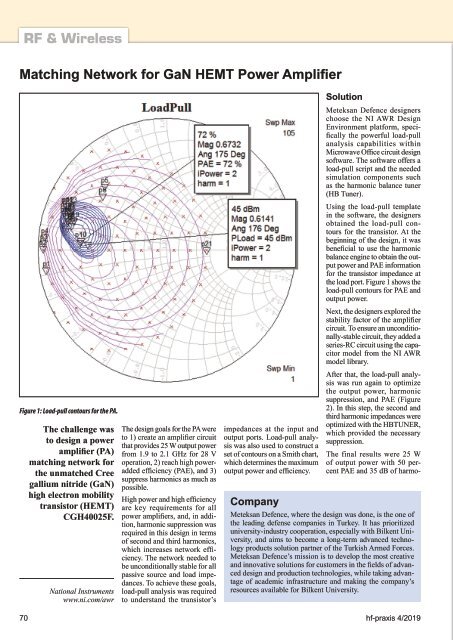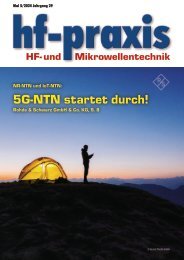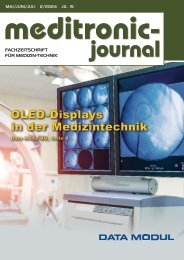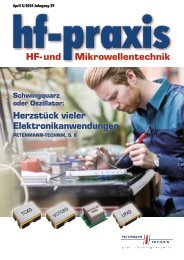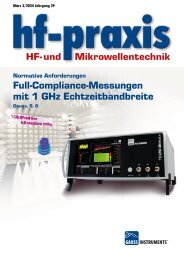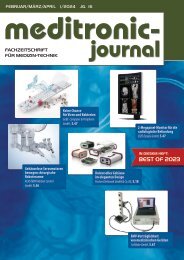4-2019
Fachzeitschrift für Hochfrequenz- und Mikrowellentechnik
Fachzeitschrift für Hochfrequenz- und Mikrowellentechnik
Erfolgreiche ePaper selbst erstellen
Machen Sie aus Ihren PDF Publikationen ein blätterbares Flipbook mit unserer einzigartigen Google optimierten e-Paper Software.
RF & Wireless<br />
Matching Network for GaN HEMT Power Amplifier<br />
Figure 1: Load-pull contours for the PA.<br />
The challenge was<br />
to design a power<br />
amplifier (PA)<br />
matching network for<br />
the unmatched Cree<br />
gallium nitride (GaN)<br />
high electron mobility<br />
transistor (HEMT)<br />
CGH40025F.<br />
National Instruments<br />
www.ni.com/awr<br />
The design goals for the PA were<br />
to 1) create an amplifier circuit<br />
that provides 25 W output power<br />
from 1.9 to 2.1 GHz for 28 V<br />
operation, 2) reach high poweradded<br />
efficiency (PAE), and 3)<br />
suppress harmonics as much as<br />
possible.<br />
High power and high efficiency<br />
are key requirements for all<br />
power amplifiers, and, in addition,<br />
harmonic suppression was<br />
required in this design in terms<br />
of second and third harmonics,<br />
which increases network efficiency.<br />
The network needed to<br />
be unconditionally stable for all<br />
passive source and load impedances.<br />
To achieve these goals,<br />
load-pull analysis was required<br />
to understand the transistor’s<br />
impedances at the input and<br />
output ports. Load-pull analysis<br />
was also used to construct a<br />
set of contours on a Smith chart,<br />
which determines the maximum<br />
output power and efficiency.<br />
Company<br />
Solution<br />
Meteksan Defence designers<br />
choose the NI AWR Design<br />
Environment platform, specifically<br />
the powerful load-pull<br />
analysis capabilities within<br />
Microwave Office circuit design<br />
software. The software offers a<br />
load-pull script and the needed<br />
simulation components such<br />
as the harmonic balance tuner<br />
(HB Tuner).<br />
Using the load-pull template<br />
in the software, the designers<br />
obtained the load-pull contours<br />
for the transistor. At the<br />
beginning of the design, it was<br />
beneficial to use the harmonic<br />
balance engine to obtain the output<br />
power and PAE information<br />
for the transistor impedance at<br />
the load port. Figure 1 shows the<br />
load-pull contours for PAE and<br />
output power.<br />
Next, the designers explored the<br />
stability factor of the amplifier<br />
circuit. To ensure an unconditionally-stable<br />
circuit, they added a<br />
series-RC circuit using the capacitor<br />
model from the NI AWR<br />
model library.<br />
After that, the load-pull analysis<br />
was run again to optimize<br />
the output power, harmonic<br />
suppression, and PAE (Figure<br />
2). In this step, the second and<br />
third harmonic impedances were<br />
optimized with the HBTUNER,<br />
which provided the necessary<br />
suppression.<br />
The final results were 25 W<br />
of output power with 50 percent<br />
PAE and 35 dB of harmo-<br />
Meteksan Defence, where the design was done, is the one of<br />
the leading defense companies in Turkey. It has prioritized<br />
university-industry cooperation, especially with Bilkent University,<br />
and aims to become a long-term advanced technology<br />
products solution partner of the Turkish Armed Forces.<br />
Meteksan Defence’s mission is to develop the most creative<br />
and innovative solutions for customers in the fields of advanced<br />
design and production technologies, while taking advantage<br />
of academic infrastructure and making the company’s<br />
resources available for Bilkent University.<br />
70 hf-praxis 4/<strong>2019</strong>


